The 'modernisation' project of building the Kashi corridor has resulted in the unabated destruction of centuries-old temples and their surrounding areas.
Catastrophic ‘Kyotoisation’ of Kashi

Perhaps six-seven years have passed. It was three hours past midnight on a rainy day in Kashi, often considered to be the oldest surviving city in the world. I finished my Ganga snan and turned to Kashi Vishwanath, one of the twelve Jyotirlingas. As there was hardly any rush early morning, I got a good glimpse of Baba Vishwanath. The ambience was intrinsically spiritual and echoing with the Shiva Stuti – ”brahma murari surarchit lingam”. The temple is mentioned in the Kashi Khand of Skanda Purana and Vishwanath is not the only deity here as he resides here with his complete family and his ganas.
Kashi is not just an eminent pilgrim centre but a bastion that also embodies the story of the resilience of Hindu civilization. The inter-generational-civilizational memory of Hindus is perplexing, to say the least. Whenever we had enough power, we rebuilt the temple of Puranic importance but unfortunately, in modern India, Hindus have not been able to reclaim the ‘original site’ of the temple which is still crushed under the Mosque of Aurangzeb.
The Heritage
In 1194, Aibak razed the original Kashi Vishwanath Temple. A Gujarati merchant rebuilt it. The temple was again destroyed by Sikander Lodhi but Rajput Raja Man Singh and Todar Mal rebuilt it again in 1585. In 1669, the fierce resistance of Naga Sadhus could not stop Aurangzeb from destroying it yet again. It is said that the mahant jumped in the Gyan Wapi well, with the Shiva Linga, to prevent it from getting desecrated. In 1780, Maharani Ahilya Bai Holkar of Indore rebuilt the temple, not at the original site but adjacent to it. Later, many Hindu princely states generously donated for the reconstruction of the temple complex and the ghats.
The Temple is built in ancient Panchayatnama style where the ‘Mool-Nayak’, that is Vishwantha, resides in the ‘Mool Mandir’. The Shikhar of the Mool Mandir is gilded with gold donated by Maharaja Ranjit Singh of Punjab in 1831. It is surrounded by temples in the four corners. In the northeast stands the Annapurna temple, in the southeast the Avimukteshwar Mahadev, Parvati Temple in the northwest, Laxmi-Narayan temple in the southwest. The low-roof colonnade with over forty pillars in the Gyan Wapi precinct was built by Baiza Bai, widow of Maratha Ruler Daulat Tao Scindhia of Gwalior state.
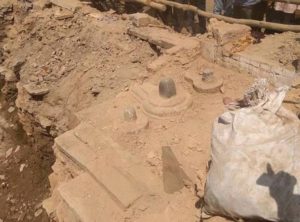
{Vigrahas demolished}
The king-size Nandi of the original temple faced the mosque and appeared to be waiting for the liberation of the original site. Close to Nandi, there was the Gyan-Wapi well, also known as the Ishan-teerth. Kashi Khand says that by just touching it, one can accumulate the ‘sacred-merit’ or punya of Ashwamedh Yajna. By doing the ‘achman’ one can accumulate punya of Rajasuya Yajna.
The Saraswati vigraha at the Sarawasti Phatak is said to be established by Vyasa himself, for the deliverance of the Kashi people from a curse that made them lose their knowledge, wealth. This anecdote finds its mention in Shri-Lakshmi Narayan Samhita. Similarly, the Apsareshwar Mahadeva was established by the Apsaras, the celestial maidens. And the Draupaditya and Panch Pandaveshwar were established by Draupadi and the Pandavs respectively.
Not only for the ancient vigrahas, Vishwanath temple is also noted for the many trees that were either mentioned in shastras or stood there for ages. Whenever the name Akshayvat tree is taken, either Prayagraj or Gaya pops up in mind. But there is an Akshayvat tree in the Vishwanath temple too. Acharya Nakuleshwar came here with his disciples and gave them the ‘Tatva gyan’. Since Nakuleshwar Mahadeva resides within the Akshayvat, therefore the tree is ancient too. Traditionally, the Sanyasis and dandi-swamis take food under the Akshayavat.
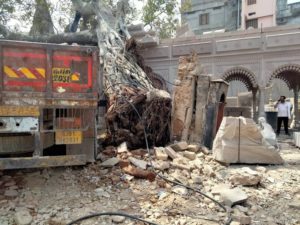
{The historic ‘AkshayaVat’ tree uprooted}
These temple vigrahas were not randomly placed, their place is distinctly mentioned in the Kashi-Khand of the Skanda Purana, with the Pauranic anecdotes and punyas related to it.
स्थानस्य महत्वम्
स्थानं प्रधानं न बलं प्रधानं,
स्थाने स्थितः कापुरूषोऽपि शूरः ।
अर्थ- स्थान प्रधान है, बल प्रधान नहीं है । स्थान के प्रभाव से कापुरूष भी शूर हो जाता है
The place is of primary importance for power as it even makes the coward courageous.
It was titillating to imagine how after every invasion, pillage and destruction, Hindus would come together and resurrect the lingams, vigraha at the same place as mentioned in the Shastras.
There were rows of Shivalings, known as Kashi-Kachehari, a Vigrah of Kapil Muni. One sadhu was doing ablution of the lingam, singing ‘mere shiv-mere shiv‘ while another was in deep meditation.
It is said that Kashi is established in the form of a Yantra, therefore it is easy to excel here in spiritual practice. Many neo-gurus try to give scientific explanations to the abstract experience using vague terms like ‘energy’ etc. I prefer not to use such lingo and rather believe what the Puranas and folk-lore say.
I was trying to observe the small details in the architecture. The government-appointed caretakers of the temple had painted over the stone structure that damaged the intricate carvings. The surface of the walls was visibly eroded and there was news that the gold leaf broke off the gilded shikar.
Traditionally, the design, construction and repair of the temple have been associated with the Vishwakarma Shilpins who were ‘Vastu-Tatvajan’, ‘nimitha-shakuna’, jyotirgyana prabodhakah, ganitagayah’ i.e. well versed in sacred architecture, studying portends, applying calculations. These artists built and maintained ancient temples that are majestic even today.
For modern-day employees, it would be just a job to get paid but for shilpins, constructing and repairing the temple was a way to attain liberation.
Those craftsmen have vanished in the mists of time, but Kashi lives on. Its vigrahas stood at the same place as they did centuries ago, the same mantras are still chanted to praise Bhagwan. Women do abhishek and place bel-patra while singing the same folks songs of yore. Many who are unable to serve their ishta as per the prescribed rituals, establish their vigraha in Kashi, knowing very well that their gods will be taken care of.
Travelling here may be a source of amusement for foreigners but for folks from the hinterland in India, they hope to do ‘the Kashi-Yatra’ once in their lifetime. ‘Kashi-yatra’ is not any random strolling. Since ancient times pilgrims have been doing ‘Shri Kashivishwanath antah-grahi pradakshina yatra, Navagraha yatra, Rudra hanuman pradakshina yatra, chappan vinayak yatra etc. Shastras mention 84 such yatras. Every yatra has a specific number of deities whose temples are visited by the devotees after they take ‘samkalp’ at the Vyas Bhavan, another historical monument. It is fascinating to know that people of today, literally walk through the same path, bowing to the same lingas, same vigraha, in the same way as their ancestors once did.
“Tradition is not worshipping ashes but the preservation of fire”.
The Kashi Yatra is the act of preservation of fire. It reaffirms our belief in rebirth, the concept of ‘paap’ and ‘punya’, It reminds us of our ultimate goal of moksha. It gives us a chance to come in close contact with the place where once our great seers mulled over the ‘tatva-gyan’, it gives us the opportunity to return our ancestral debt by performing the ’Shraadh’. Kashi reminds us of our Hindu Civilisational Identity.
Pondering over our identity, I moved out of the Vishwanath Temple. Treading the narrow lanes-bylanes was like entering a time warp. It was not hard to identify century-old houses, unlike the characterless flats of urban India, the houses of Kashi were aesthetic. Temples that were attached to the houses, had bal-batuks practising their Sanskrit lessons.
Once Tulsi, Kabeer, ChandraShekara Azad had tread these lanes. I was walking through the living museum, feeling remorse over my lack of knowledge in identifying the gems I was passing by.
In the evening, I once again went to the Kashi-Vishwanath Temple to witness the Saptrishi Arti, one of the most sublime experiences. It is said that Saptrishis once sang the aarti to please Shiva. The tones and rhythm have been passed to the brahmins of seven gotras who have been regularly singing at the Kashi Vishwanath for centuries. As the aarti ended with the pushpanjali mantra, I was in tears as I felt the presence of the ancients who had been here before.
Adi Shankaracharya called Kashi the cosmic centre of the world. It is such a sacred space for the Hindus, that even dying here liberates the soul. Hindus from all over the Indian subcontinent have been immigrating to Kashi. In the sixteenth century, Khatri traders settled here, popularly known as Lahori Tola. Similarly, Marathi Tola, Bangali tola, Tamil-Tamil-Kannada people have institutionalised themselves. Ancient-medieval Kings gave grants to build temples patronized Vedshalas in the Kashi-kshetra, traders built dharma-shalas to immortalize their name in sacred history. Kashi in the truest sense has sported a cosmopolitan character.
No wonder that in 1736, when Mughals were trying to reach a truce with Peshwa Baji Rao, the latter asked that Prayag, Kashi, Gaya, Mathura be ceded to him. Releasing the antiquity of Kashi, I resolved to be more well-read and cultured the next time I came here.
Never did I realise that it’d be the last time I was would be seeing the Kashi-Vishwanath Temple and the adjoining lanes as they were. The change was imminent.
Supreme Leader: the Personification of Krishna or Paundrak?
In 2014, Narendra Modi famously said ‘Na mujhe kisi ne bheja hai, aur na mai yahan aya hu, mujhe toh maa ganga ne yaha bulaya hai’. Hindus were hopeful, Kashi was hopeful that Ganga would be ‘aviral-nirmal’ and that the Kashi Vishwanath temple would reclaim its old glory, free from the sign of tyranny as the mosque would remain no more. With a record margin of 3.37 lakh votes in Kashi, Modi won the seat and became Prime Minister.
With this, the ‘Kyoto-isation’ of Kashi-Vishwanath began as locals were enthusiastic about the initial plan of the Kashi Vishwanath corridor in the form of ‘Anand-Kanan’, ‘Garden of eternal-pleasure’. A devotee directly after Ganga snana could go to Vishwanath while taking a heritage walk through the garden.
But in the summers of 2018, an exasperated Swami Avimuketashwaranand, the representative of Shankaracharya peeth of Dwarka, was taking padayatra over the mishandling of the vigarahas of the puranic and other ancient temples. By now it was clear that officials handling the project were insensitive to the rituals associated with the deities. They literally locked the deity or razed every temple that came in the way of the corridor. The visuals were appalling as those vigrahas that were served since antiquity were now torn down, thrown in the drain, People were yet not ready to blame Modi for this wanton destruction, officers were blamed for it. Few went ahead to declare Swami Avimukteshwaranand as a Congress agent. Anyway, Swami’s movement died as expected.
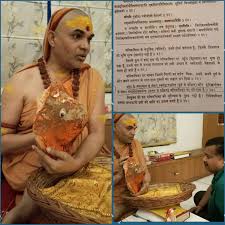
{Swami Avimuketashwaranand}
The blunder was happening on two levels. First at the level of Shastras. A Pran-pratishthit vigraha is a ‘living’ deity, the pujari treats it like a living entity. Not letting regular puja or bhog be done was anti-shastras. Razing or tearing down the vigraha was synonymous with nothing less than murder.
Since officials now are largely culture-less seculars, they were least expected to follow Shastras but did they at least follow the laws? The Ancient Monument Preservation Act 1904 and The Ancient Monuments and Archaeological Sites and Remains act 1958 aim at the ‘preservation of ancient monuments, an object of archaeological and historical or artistic interest’, ‘which has been in existence for not less than 100 years’. Despite this, the authorities brazenly destroyed thousands of years old vigraha, temples while also disrupting rituals which were eventually discontinued.
Letters after letters were written that fell on the deaf ears of the PMO. Business went as usual. Officials became more ruthless under the PMO and CMO offices. Swami Avimukteshwaranand kept posting images of partially destroyed vigrahas, locked or destroyed temples on his social media pages.
In the first week of May in 2020, something unexpected happened. The centuries-old saptrishi aarti, conducted by brahmins of seven gotras, was performed on the road, in front of the entrance of Kashi-Vishwanath temple, as the then CEO of the project, PCS Vishal Singh was not happy with the chief archak Guddu Maharaj because he had leaked information about the Kailash temple in the Viswanath complex being damaged. The Official did not let them enter the temple and hence the aarti was performed on the road. It was now official that Officials considered themselves above Vishwanth himself, and their ego was ruling the sacred space not the ‘shastras’.
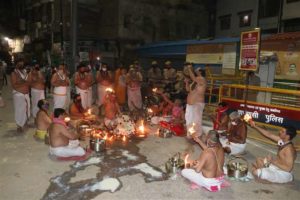
{The centuries-old Saptrishi Aarti, was performed on the road}
I was fortunate enough to be in the Kashi Vishwanath Temple this year on the evening of Holi. I paid 180 rupees for the Saptrishi Aarti and hence could enter the temple without being in the queue. The temple was more open and spacious but the Vigrahas and Shiva lingas were visibly less. Neither ‘Kashi ka Kachehari’ was present nor the Vigrah of Kapil Muni. The Officials had not only removed the shiva-lingas in the temple courtyard but also from the adjoining lanes. I tried to interact with one of the archaks of the saptrishi aarti. He was not ready to talk, very tight-lipped he told that the government was conspiring to remove them and appoint some paid archaks. ‘Paid archaks! Can they do the rituals like the specialists who have been doing it for generations with shradha’? The archak smirked and said ‘yaha sab kaam bubblegum khane wale archak karenge’.
Those who had the pass sat in front of the garbh, including beef-eating whites while the rest of the bhakts could only get a peek, if they could!
Modi and his officials often say that ancient temples are being restored by ASI and that the shastras are not compromised at any step. Officials have maintained that the vigrahas have been removed using the ‘Chaalan’ doctrine and they are kept in a secured place where daily rituals are being conducted. Obviously, they are lying. Vigrahas were either damaged, covered in tyres, lying in open or even thrown in drains. Many vigrahas were even discovered in a police station in a damaged state that was later adopted by Swami Avimukteshwaranand.
Moreover, dharm-shastri Avadh Ram Pandey contradicts the application of ‘chalan-paddati’. He says that this is applicable when the temple and the vigraha are damaged naturally by wind or river flow or chandalas have been eating meat nearby. Even in those cases, the damaged vigraha is reconsecrated with Panchang pujan, havana evoking gods in sarvatobhadra mandal. This is how chalan paddati is observed in temples in southern India. However according to Aagam shastras, Bhrigu Samhita, if the Shivalinga is established by a Devata, Rishi or the tatvajnais then it should be worshipped despite being damaged.
“स्वायन्भुवे च देने च बाणलिंगे तथैव च। ऋषिमिश्चासुरैदेवैरतत्वविदिमः प्रतिष्ठिते।
लिंगे जीर्णादिदुष्टेपि नोद्धरं तंत्र कारयेत्”
Although BJP veterans have historically asserted ‘mandir wahin banayenge’, because the place, the shastriya katha associated with the deity is very important, bhakts have mysteriously turned Shiva-Drohi in Kashi. The place and vigraha are no more important it seems now.
In the last week of April of 2021, something sinister was about to happen. The historic ‘AkshayaVat’ tree in the Vishwanath courtyard fell mysteriously ‘on its own’, even when there was no rain or storm. Mahant Bachcha Pathak and Raju Pathak cried foul that the government conspired to kill ‘Baba Akshayvat’, as it was an obstruction in the grand corridor. He was given written assurance on stamp paper that trees won’t be touched but they cunningly damaged the base and support of the old tree that led to its collapse.
Just like how the Congress and the Left have been denying the existence of Shri Ram, the BJP IT cell denied the existence of any ancient Akshayvat tree. Notwithstanding, the Kashi Khand of the Skanda Purana mentions it. Even if the benefit of the doubt is given to the government, the historic tree was ancient, they could have replanted it. But the Tree was ‘killed’. Later mahant Raju Pathak and his family were put under house arrest.
Any structure or tree that lawfully needed to be protected, officials simply dug its base from all sides and the old structure or tree collapsed on its own. That’s how they evicted the present mahant of Vishwanath Temple Dr. Kulpati Tiwari from his ancestral house.
Modi enjoys a huge trust surplus, therefore protesting voices including the old Sangh loyalists have often been discarded. Rishi Kumar Jhingran has been associated with the ABVP and RSS for some twenty-two years. He lives a mere hundred meters away from Vishwanath Gali. Once he used to be an enthusiastic supporter of the corridor as it promised better facilities to the pilgrims. ‘But now all governments seem to care about is just foreign tourists’. Rishi had warned two months beforehand on Facebook about the officials conspiring to destroy the Akshayvat tree. He says that the officials have razed some 12 ancient and sacred banyan and peepal trees and filled 12 wells of historical importance.
Even before cutting an ordinary tree, a traditional Takshak, first worshipped his tools by applying honey and butter and then chanted mantras from the Samhitas seeking forgiveness of the tree. Redundant wells are covered but never filled as destroying sacred trees and wells is considered inauspicious.
But the real shocker was yet to come. During the lockdown when there was hardly any crowd in the temple, the officials destroyed the ancient panchyatam style of the temple. The four temples of Avimukteshwar Mahadev, Parwati, Lakshmi Narayan, Annapurna established in the four corners of the ‘mool-mandir’ have been removed. Their Shikhars have been destroyed.
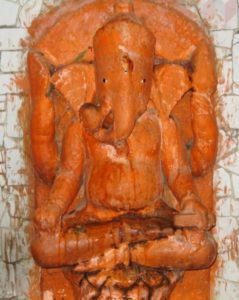
{Dwar Vinayak of Kashi Khand of Skanda Purana, missing now}
Even if we forget the heritage value, what moral right did the Modi government have to destroy the Temple constructed by Ahilya Bai Holkar and other kings?
Prof Ratate has prepared a list of at least 120 Shiva-lingas and vigrahas like Panch-Pandav, Bhgairathi Vinayak, Gajanan Vinayak, Dwar Vinayak etc vigrahas mentioned in Kashi Khand of the Skanada Puran, that come under the proposed corridor. Many of the Vigrahas in the list were either desecrated, damaged or missing. If these vigrahas and lingas are lost or destroyed, then it would lead to the destruction of ancient Kashi-Yatras.
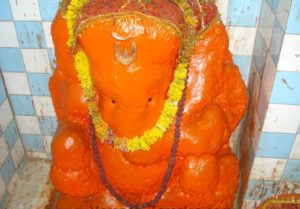
{Missing god, Durmukh Vinayak}
The regular devotees are flabbergasted to find the sapt sarasvati i.e. Padmanilya, Gyanmudra, Vagndevi, Sarvdevstutah, Survandita, Varprada, Mahasaraswati established by Yajnavalka Rishi missing, Sarasvati vigraha that was said to be established by Vyas himself is missing too. Either they have been broken and thrown or kept somewhere else. Similarly, Nakuleshwar Mahadev, the one who resided in the Akshayvat tree has been lost in the debris. Forget regular Rudra-abhishek or puja, the Indian state is not letting the pujaris and devotees have a glimpse of their gods. Locals have alleged that officials tried to fool them by showing fake murtis but were duly caught.
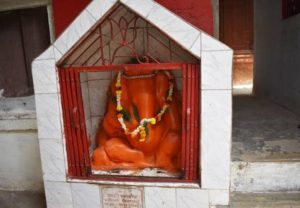
{Bhagirath Vinayak mentioned in 57th adhyaya of Kashi Khand, missing now}
The voices are going unheard and the destruction unnoticed, all thanks to the officials’ superlative management skills. Kashi-Vidwat-Parishad, the organisation that has been guiding the locals for decades, has been infiltrated by ‘yes-men’, the ones who introduced the dubious ‘Chaalan paddati’. Officials have made the best use of the lockdown to demolish the temples in seclusion while spreading systematic lies.
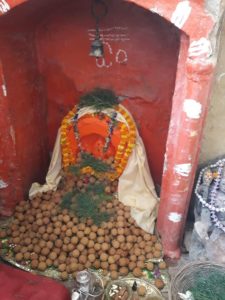
{Pramod Vinayak of the Kashi Khand of the Skanda Purana, missing now}
On March 8 2019, the PM arrived in Varanasi to do the ‘Shila-Pujan’ of the corridor. In his address, he said that today is the liberation day of Bholebaba, as he was trapped within the walls for centuries. He appreciated the officers who acquired some three hundred properties. He then made an extraordinary claim that at least forty ancient temples were discovered that were actually encroached by people in bad faith. News portals echoed the news of the discovery of a Samudragupta era temple, with encroachers having made a washroom on its top.
Kashi in general and Vishwanath Temple, in particular, have been the target of Muslim Invaders. With the disintegration of the Mughals in the eighteenth and nineteenth centuries, there was a great rise in the rebuilding of temples in Kashi. Most of the houses belonged to that period, although the settlement is ancient. Since temples and houses belonged to the same period, then how can the owners be called encroachers? Senior journalist Padmapati Sharma contends that people tactfully settled in close proximity, making the settlement appear like a labyrinth of lanes and took the temples within their boundary to resist invaders.
The Kashi Vishwanath Temple is not grand, hardly four to five archaks can fit in the sanctum, even the door is very small. It is not hard to understand that such a small design was made with the purpose of resisting the hordes of invaders.
North India was under Islamic occupation for more than 700 years. It is impossible to find Gupta-era temples in their original shape. If any such temple is really located here, then the Kashi-people must be praised for saving the temple as it is, rather than being ridiculed for gobbling it inside their house.
The house number with the complete address of every single Vigarha, every single shiva-linga mentioned in the Kashi-Khand of the Skanda Purana is meticulously documented in the book Kashi-Vaibhav. The speech by Mr. Modi which states that 43 hidden temples were discovered in the houses, few being used as kitchen or washroom was an egregious insult of Kashi-vashis. And even if it is true, the shiva-lingas-vigrahas resided there with full respect and served regularly. Now, we don’t know if they exist or are buried below the ‘Dharmic-malls’, the phrase used to refer to new constructions.
It was in the lanes of Kashi where the gems of history were scattered. The government acquired some 300 old houses and structures, most of that was 250 years old, only to demolish them. On the condition of anonymity, one local expressed dismay over the razing of the entire Lahori tola, which included the house of Hindi writers like Devki Nandan Khatri.
House of journalist Kameshwar Mishra, the father of Hindi shorthand, Karmaical library, one of the oldest libraries of Uttar Pradesh as well as the house belonging to the posterity of Mandan Mishra have been demolished to the ground. His idol was thrown in the debris.
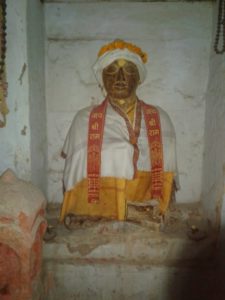
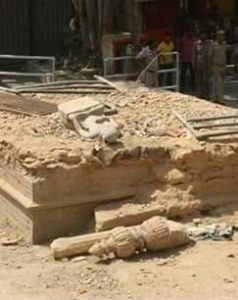
{House of Journalist Kameshwar Mishra- before and after}
Kedarnath Vyas, the posterity of the mahant who jumped into the well with the Shivalinga when Aurangzeb attacked Vishwanath, was still fighting a forty-year long court battle for the original site, even though his ancestral house was not spared. He died a dejected man in a rented place.
RaghuPrasad Goenka, a businessman from Calcutta had built a residential library for the disciples as well as acharyas in 1926. It was the ultimate stop for doubt related to dharma-shastras. Its original shape has now been changed after partial demolition.
People lived in their ancestral houses for 10-12 generations, they were not allowed to repair their house by the previous regimes for being heritage. What changed after Modi is that this heritage was now demolished in its entirety.
Cultural tourism gives the chance to the visitor to learn the tangible and intangible of a place through its arts, architecture, lifestyle and value system. The government plans to raise revenue by advertising the cultural tourism of Kashi at the same time by demolishing the repository of the culture itself.
Only the Muslim community is vigilant of its religious structure. News portals like The Wire or Quint have already made documentaries on the Mosque. In one episode, during the demolition drive, a two-foot chabutra at gate number four of Gyanwapi belonging to Muslims was demolished, within no time 1000 of them assembled and official Vishal Singh had to get it rebuilt at 2 a.m. itself.
Anyone who thinks that Mr. Modi can ever reclaim the original site of Vishwanath is delusional as the officials do not have the guts to touch any Muslim structure. On the contrary, they are importing Muslim labourers from Malda of West Bengal to break the vigraha and raze the temple. The poor Hindu labour seemed to have more dharma left than the cultureless officials.
On June 1st 2021, a dilapidated building in the corridor collapsed upon the labourers while they were asleep. Abdul Momin and Aminul Momin died on the spot while Arif Momin, Shahid Akhtar, Sakhiyul Momin, Hakim Khan, Arif were injured. The PM who keeps mum over the Palghar incident was kind enough to call the commissioner and announce five lakhs compensation to the dead and fifty thousand to the injured.
Kashi in her most horrid nightmare wouldn’t have thought that under the regime of Hindu Nationalist PM Modi, Mulsim labourers would be brought in to destroy gods and their temple by secular officials in the sacred space of Hindus with garbage also coming out of the Vishwanath gali filled with beer cans and pieces of meat.
More disaster: Altering the Sacred Geography
There are many cities on the banks of Ganga, Kashi is unique because Ganga makes ‘Ardha-chandrakar’ or crescent shape here. Unlike Kanpur or any other city, the ghats in Kashi always touch Gangaji. Traditional shilpins had built ghats in accordance with the natural flow and nature of Gangaji. That’s why they don’t obstruct the flow and survive without repair. Very rarely water recedes to the extent that the end step of ghats gets visible but not anymore.
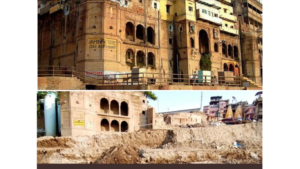
{Jalasen Ghat, the fort built by Marathas. Before and after renovation}
With much pomp, the Namami Gange project was launched in 2014 but it is turning out to be yet another disastrous event.
On May 28, 2021. Natives of Kashi saw Ganga as she had never seen before. The water on the Lalita Ghat had turned green due to the appearance of Microcystis Algae. Such phenomena are usually observed in stagnant ponds but never in Ganga. Forget drinking or bathing in such water, the odour was so intense that it was impossible to stand on the Ghat.
For Hindus, the Ganga is a manifest goddess but post-independence Ganga has been ruthlessly exploited by governments for their revenues. Mr. Modi is not only following in the footsteps of his predecessors but also taking giant leaps ahead.
The government is building a platform that would be a hundred feet long and 150 feet wide on Lalita Ghat as part of the grand corridor. Veteran journalist Suresh Pratap who has been observing the operation of the corridor says that the 800 meters distance of Mir Ghats to Manikarnika shamshan was first pumped with sand from the river bed using huge motors and then to make it stable, lakhs of plastic sacks filled with sand were dumped upon it. Finally, the thousands of trolley debris of demolished structures were dumped on the sacks, upon which the platform is being raised. Such obnoxious and unnatural construction has obstructed the natural flow of the river causing it to be stagnant and letting the algae flourish. Moreover, the crescent-shaped Ganga is also getting destroyed due to this.
‘Mujhe maa Ganga ne bulaya hai’, even Ganga wonders why did she call him? The PMO and CMO appear to be in full mood to run riot as they are making a ‘mobile boundary canal’ of 45 meters top width, 32 meters bottom width, depth of 65 meters and length of five km on the sand bed of the opposite banks of the river. A number of cranes have been employed to dig the sand and make the canal stable, plastic sacks filled with sand have been used to provide stability to the canal.
Veteran River engineer Prof (Dr) UK Chaudhary of IIT BHU, author of books like ‘Living similarities between Ganga and the Human Body’ and ‘Five theories of River Management’, asserts that this canal under no scientific principles can bear the momentum and turbulence of the floodwater. It will reduce the depth of water in the Ganga. Further, the reduction in-depth during the monsoon will cause the reduction in velocity which will ultimately cause heavy siltation making mounds of silt and sediment on the side of the ghats. Just like how Ganga has left the Ghat at Assi, it will leave the consecutive ghats up to Dashashwamedh, where grand Ganga Arti is conducted.
Thus the Kashi known for its water touching ghats will now be converted into ghats filled with mountains of silt.
Prof Chaudhary has written letters to the UP CMO asking several technical questions and highlighting the loopholes of the proposed designs and their probable negative impact. As always, the CMO did not even bother to address the concerns.
The Deadlock
For the last four years, I have been living in Delhi and observed that deep down Hindus, here, are atheists. They may flaunt selfies in Kedarnath but hardly follow any rituals related to rites de passage. Even the 13 days death ritual is conducted in two days. Forget Shradh rituals, they might not even know it.
Kashi was perhaps the last bastion where Dharma is practised as per the Shastras. Even to this day one may find brahmins who are initiated at early boyhood, spend time in Veda-dhayayan and then retire to vanprastha when they turn fifty. It was just two generations ago that dharmavlambis used to travel across the sacred perimeter of Kashi to defecate, as the land of Kashi was too sacred for the purpose. Great grandfather of pandit ChannuLal Mishra used to sing thumri in Sanskrit. Mr. Modi was expected to revive the soul of Kashi. But he had other ‘dreams’. Dreams of building a multi-storey guest house, cafeterias, recreation centres and selfie points on the dead, on ancient temples, centuries-old settlement, libraries and pathshalas and the soul of Kashi.
The dream kept gobbling one gali after another as people fear if the dream spreads its tentacles in Bhairao Nath gali. Speculation is rife about further demolition, perhaps officials are preying on the replica of Pashupatinath.
But this is just the tip of the iceberg. Rumours indicate that there are great financial irregularities in the temple funds, embezzlement of antiques and valuable metals discovered while digging the foundation of ancient temples. Rumours add up that many ancient vigraha were razed just as they were useless in the Modi Model as they didn’t generate enough revenue.
Borrowing a phrase of a local ‘ab guest house se gaadi seedha baba ke muhane par rukegi, ab log baba ka darshan karne nahi darshan dene ayenge, aur mandir Snan-dhyan-daan-gaan nahi paap-vyabhichar ka adda banega, ghat par shstrasth nahi disco light me dj toh bajta hi hai’
Is there any way for redemption? Perhaps by rebuilding temples and establishing the vigraha on the same spot followed by extreme prayaschitta by people involved. Is this possible??
Kashi may have survived Aurangzeb but may not survive the dream project of the Leader.

Leave a Reply